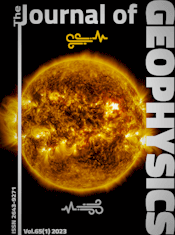Archaeomagnetic study of medieval fireplaces at Mannheim-Wallstadt and ovens from Herrenchiemsee (Southern Germany) and the problem of magnetic refraction
Article Sidebar

Vols. 1-18 (1924-1944), ISSN 0044-2801
Main Article Content
Abstract
Ten fireplaces from Mannheim-Wallstadt (MW) and four ovens from Herrenchiemsee (HC) were studied with regard to their archaeomagnetic properties. The ages of the medieval structures were only poorly known and an age dating was intended with the help of the standard curves for the declination and inclination of the geomagnetic field of the past 2000 years, as set up by Thellier (1981) for France. The stability of the NRM was tested with Thellier's test. Of the ten MW fireplaces, only one passed the test, whereas of the four ovens of HC, all passed the test but one of them had to be excluded because of secondary displacements within the structure. The MW fireplace could be dated to 670-700 A.D., in agreement with other archaeological age determinations for the fireplaces. The ovens from HC yielded an age between 1100 and 1170 A.D. The ovens showed the effect of magnetic refraction. Model calculations carried out on circular ring structures require a susceptibility of the oven material of the order of 0.5 SI units to explain the observed effect. The presently observed mean susceptibility at room temperature is only around 5 x 10-3 SI units. However, heating of the material at 550° C for 2 h in a reducing environment was able to increase the susceptibility by a factor of 20. This effect is explained by the reduction of secondary iron oxides and hydroxides to magnetite. Another increase by a factor of about 1.5 is obtained from the Hopkinson effect (increase of susceptibility with temperature) at the blocking temperature of magnetite. Combining all effects, it is possible to attain values for the susceptibility at the blocking temperature of magnetite as high as 0.2 SI units, which is the order of magnitude required for the explanation of the observed effect of magnetic refraction. This effect demands that special considerations be made during archaeomagnetic sampling from archaeological ovens or kilns.
 ARK: https://n2t.net/ark:/88439/y016135
ARK: https://n2t.net/ark:/88439/y016135
Permalink: https://geophysicsjournal.com/article/117
Article Details
References
Aitken, M.J., Hawley, H.N. (1971) Archaeomagnetism: Evidence for magnetic refraction in kiln structures. Archaeometry 13:83-85
Bergmann, L., Schaefer, C. (1974) Lehrbuch der Experimentalphysik II, W. de Gruyter, Berlin
Graham, I.D.G., Scollar, I. (1976) Limitation on magnetic prospection in archaeology imposed by soil properties. Archaeo-Physica 6:1-126
Harold, M.R. (1960) Magnetic dating: kiln wall fall-out. Archaeometry 3:47-49
Jackson, I.D. (1975) Classical electrodynamics. J. Wiley and Sons, London
Landolt-Bornstein (1970) Zahlenwerte und Funktionen aus Naturwissenschaften und Technik, Vol. III, 4b
Le Borgne, E. (1955) Susceptibilite magnetique anormale du sol superficiel. Ann. Geophys. 11:399-419
Le Borgne, E. (1960a) Influence du feu sur Jes proprietes magnetiques de sol et sur celles du schiste et du granite. Ann. Geophys. 16:159-196
Le Borgne, E. (1960b) Etude experimentale du trainage magnetique dans le cas d'un ensemble du grains magnetiques tres fins disperses dans une substance non magnetique. Ann. Geophys. 16:445-503
Le Borgne, E. (1965) Les proprietes magnetiques du sol. Application a la prospection des sites archeologiques. Archaeo-Physica I, Beihefte der Bonner Jahrbucher 15:1-20
Mullins, C.E. (1974) The magnetic properties of soil and their application to archaeological prospection. Archaeo-Physica 5:143-348
Rumble, D. (Ed.) (1976) Reviews in Mineralogy, Vol. 3: Oxide Minerals. Min. Soc. of America, Short Course Notes, Southern Printing Comp., Blacksburg, Virginia, USA
Schurr, K. (1983) Archaomagnetische Untersuchungen an Feuerstellen aus Mannheim-Wallstadt und Oren aus Herrenchiemsee. Unpubl. Thesis, University of Munich
Thellier, E., Thellier, O. (1959) Sur l'intensite du champ magnetique terrestre dans le passe historique et geologique. Ann. Geophys. 15:285-376
Thellier, E. (1981) Sur la direction du champ magnetique terrestre, en France, durant les deux derniers millenaires. Phys. Earth Planet. Inter. 24:89-132
Weaver, G.H. (1962) Archaeomagnetic measurements on the Second Boston Experimental Kiln. Archaeometry 5:93-104











